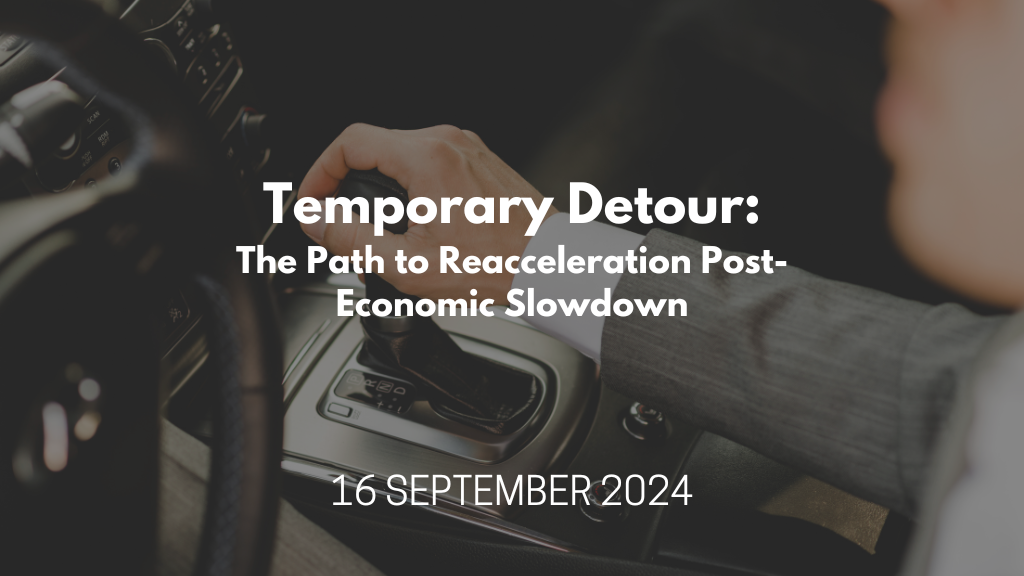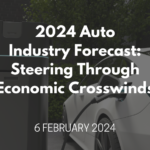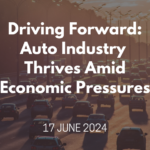In the grand scheme of global economics, the automotive industry often serves as a microcosm of broader trends. As we observe a general deceleration in economic activities worldwide, the auto sector, too, is hitting a few speed bumps. However, this slowdown is not a dead end but rather a momentary pause, with clear skies anticipated as monetary policies adjust and consumer confidence potentially rebounds, at least, that’s what we hope would happen. Because we don’t think a recession is coming any time soon, it’s just. a temporary slowdown before rate cuts happen and the economy is stimulated again.
KEYPOINTS:
- Economy is slowing down and affecting the automotive industry
- Trend towards more EV and hybrid cars being a choice of purchase
- With CPI for new and used vehicles going down, maybe it’s time to buy a car after all
- No worries, we’re not in recession territory
Global Economic Slowdown
The automotive industry’s current slowdown mirrors the global economic climate, influenced heavily by tightening monetary policies aimed at stabilizing inflation rates. While these measures have dampened consumer spending and manufacturing outputs temporarily, they set the stage for a more stable economic environment. Once central banks start to ease rates, we expect a revitalized economic engine to ignite recovery phases across sectors, including automotive.
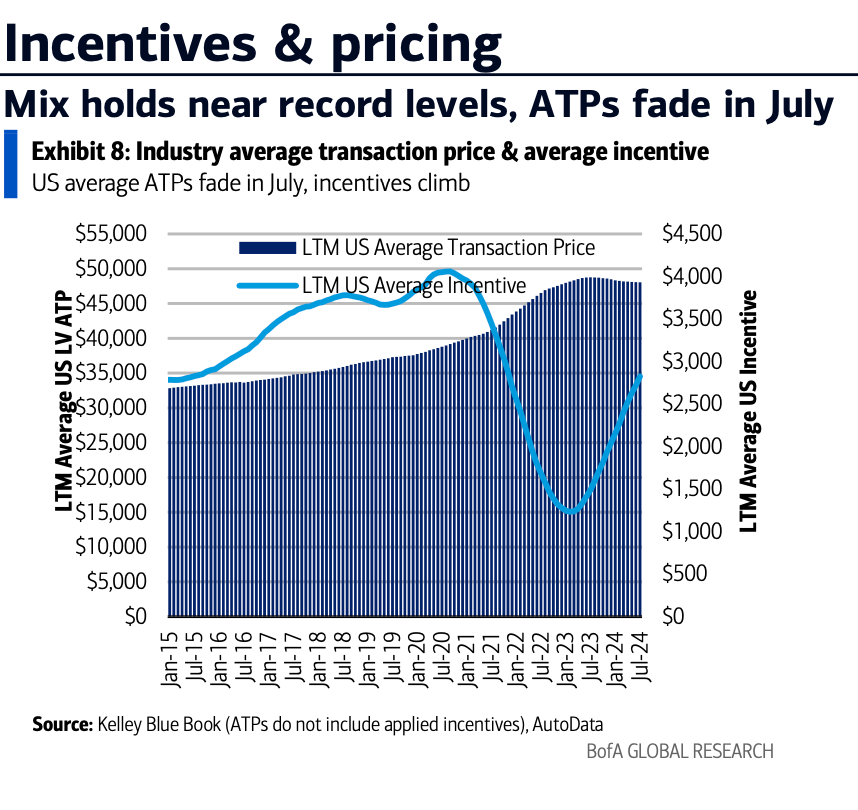
Despite the global production hiccups, average transaction prices have shown remarkable resilience, with only a minor decrease observed in July 2024. However, the uptick in incentives suggests manufacturers are striving to keep the wheels of commerce spinning, employing discounts and promotions to attract buyers amid fluctuating market dynamics. This balancing act of enticing consumers while safeguarding profit margins amid escalating production costs illustrates the ongoing challenges and adaptations within the industry.
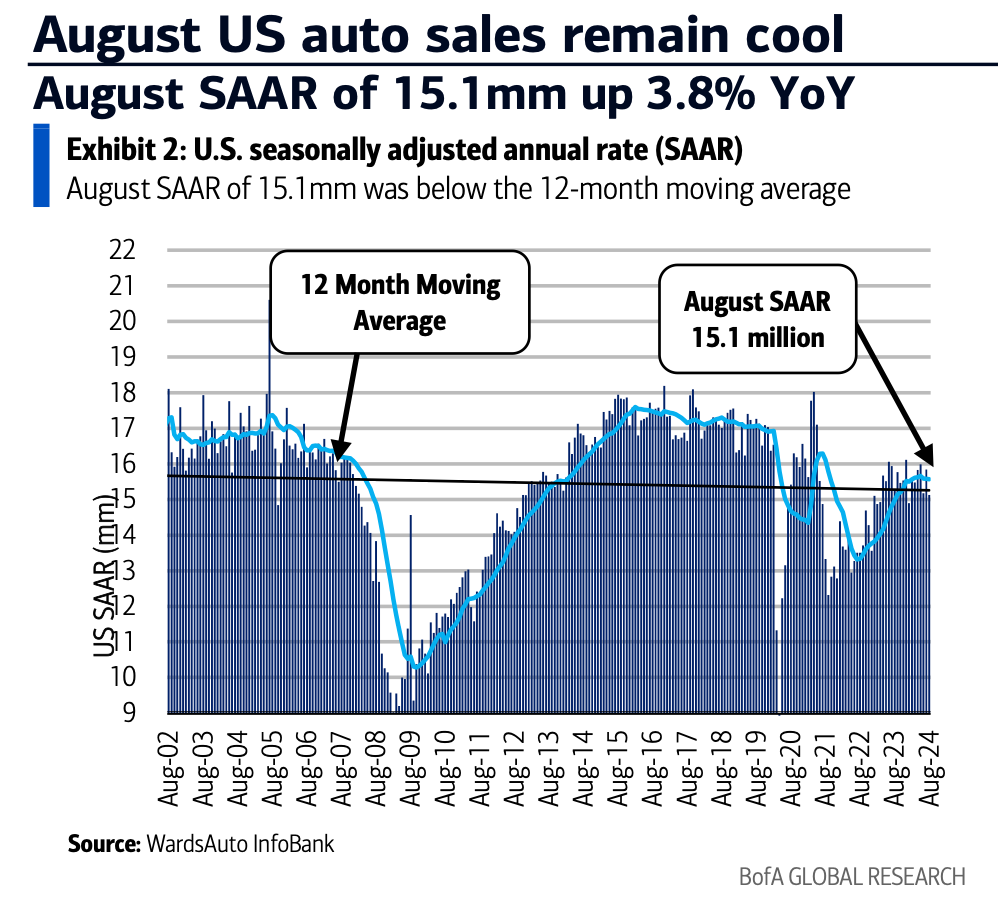
Specifically, within the automotive sector, the dip in production and sales is a reflection of broader hesitancy in consumer spending. Yet, this is likely a temporary stall rather than a long-term park. The industry has shown resilience and adaptability, shifting gears to accommodate new consumer demands and technological innovations, especially in the realm of Electric Vehicles (EVs) and sustainable practices. As monetary policies begin to relax, likely in the coming quarters, these innovations position the automotive sector on a fast track to recovery.
?Despite these minor global production hiccups (because what’s a global industry without a little drama?), average transaction prices have barely flinched—showing a stoic face with just a minor frown. The balancing act of luring consumers while protecting those precious profit margins amid rising production costs? Just another day in the thrilling world of automotive commerce! Specifically, within the automotive sector, the dip in production and sales is merely a brief pause, not a full stop. It’s like the industry has decided to take a little breather—because who doesn’t need one in these bustling times? The resilience and adaptability shown, especially with the rush towards EVs and green technologies, suggest that the automotive folks are not just sitting back. Oh no, they’re retooling, rethinking, and ready to sprint forward as soon as those monetary policy wizards start loosening the reins.
The Rise of EV Drivers
The surge in EV adoption is more than a trend—it’s a fundamental shift. Light trucks and alternative powertrain vehicles, including hybrids and fully electric models, have significantly upped their market share. This movement is spurred by a mix of environmental consciousness and a penchant for cutting-edge technology, positioning EVs not just as alternatives but as preferences. As the appeal of traditional internal combustion engines wanes, EVs are gearing up to dominate the road, supported by both consumer interests and regulatory policies advocating for greener options.
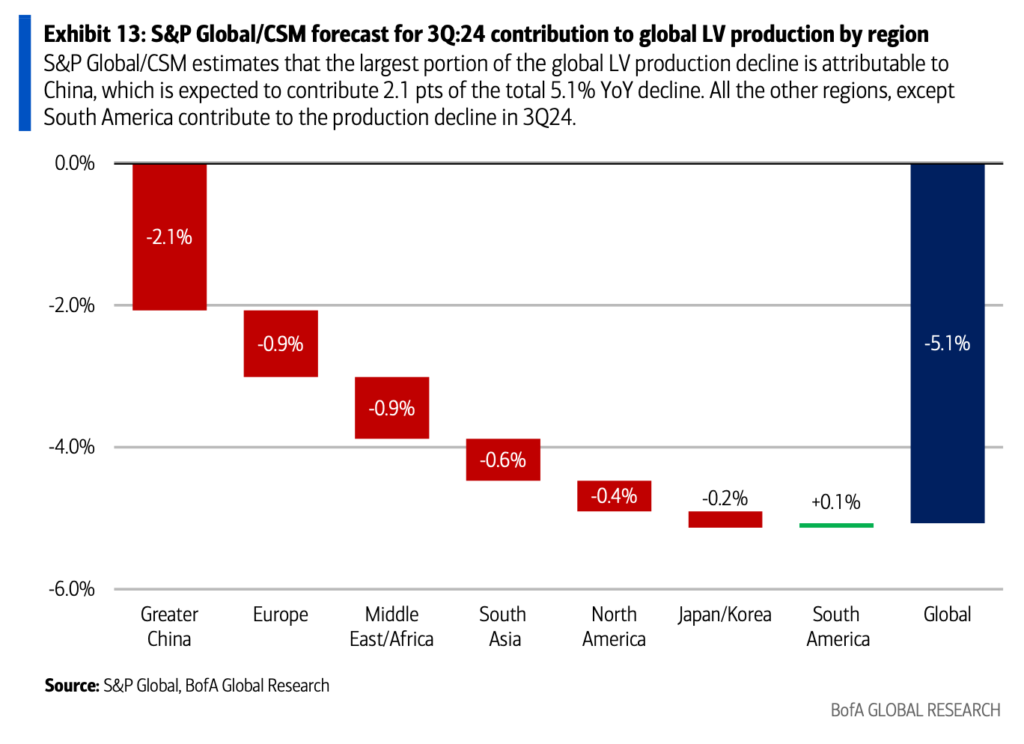
Market dynamics, particularly in regions like Europe and North America, show significant temporary setbacks in automotive production. However, with anticipated adjustments in economic policies and a gradual recovery in consumer confidence, these regions are expected to rebound, driving up demand for both conventional and electric vehicles. The infusion of EVs into the market mix, supported by favorable government policies and advancing technology, suggests a bright horizon post-slowdown.
?While Europe and North America have hit a few potholes with production snags, don’t be fooled—this is just the quiet before the storm. The expected loosening of economic constrictions and a rebound in consumer mojo are set to turbocharge demand. The EV market is being juiced up by not just consumer preferences but also by government policies pushing for a greener tomorrow. Looking ahead, the narrative isn’t just about recovery; it’s about revolution. EVs are poised to take center stage, propelled by innovations and regulations that favor sustainable growth. So, as traditional engines begin to lose their spark, EVs are charging ahead, ready to redefine mobility in a world that’s increasingly green-conscious. The road ahead looks electric indeed, promising a cleaner, more efficient horizon not just for car enthusiasts but for everyone who’s ever thought about pushing the pedal on an electric ride.
Is it a Good Time for Car Shopping?
Honestly, yes.
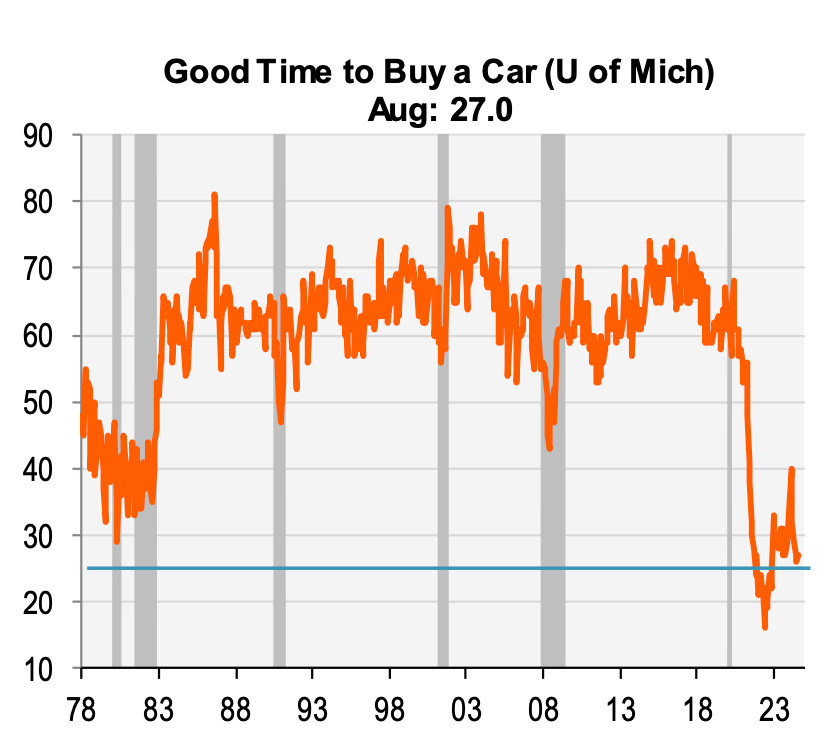
The chorus of indicators singing in unison makes it pretty clear: if you’ve been on the fence about snagging a new set of wheels, the universe seems to be giving you a nod. Between sagging consumer sentiment, swollen inventories, and a downward trend in the CPI for vehicles, the market is almost begging potential buyers to dive in. This isn’t just a clearance sale; it’s an everything-must-go bonanza.
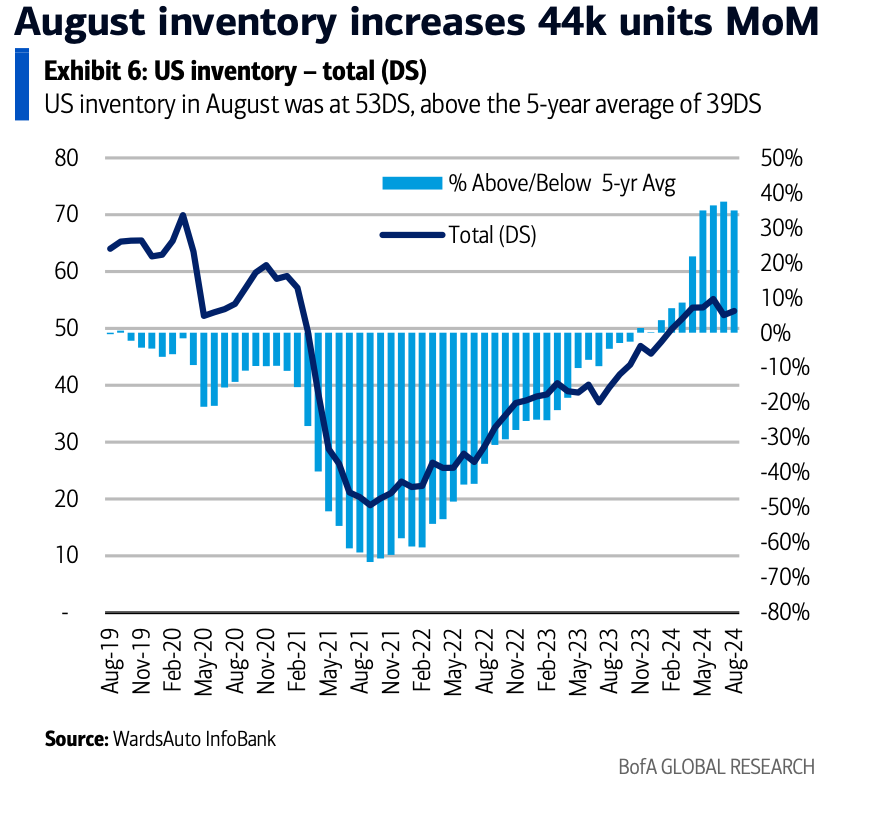
The truth in the data is as plain as the discount signs in the dealership windows. With consumer sentiment in the dumps, dealers are understandably anxious to turn their burgeoning inventories into sales, and this anxiety translates into better deals for the consumer. It’s a buyers’ market, and the downward tick in the CPI for both new and used vehicles only sweetens the deal. Incentives are the cherry on top, offering a little extra push for those still hesitating at the threshold.
This moment in the automotive market is a rare alignment of the stars where economic doldrums actually play to the advantage of the consumer. Dealers, squeezed by the need to clear lots for the next model year, are likely to offer terms that we might not see again for a while. If economic conditions shift and inventory pressures ease, this window could close as quickly as it opened.
So, if your old ride is starting to feel a bit rickety, now might be the perfect time to consider an upgrade. With conditions like these, you could drive off the lot with a deal that feels like a steal. After all, it’s not every day that economic indicators align so neatly in favor of the car buyer. Grab that steering wheel, and let the road to savings begin!

And look! CPI is going down. Given these trends in the CPI for both new and used vehicles, combined with the current economic slowdown and increased inventory levels as noted earlier, there are compelling reasons for buyers to consider entering the vehicle market now. Dealerships are likely to continue offering attractive incentives to move inventory, particularly if they do not foresee a quick uptick in demand.
?But hold up, even though the inventory glut might suggest a buyer's market, the broader economic context—especially those pesky interest rates—plays a pivotal role in determining the true affordability and wisdom of purchasing a new vehicle right now. It’s like finding a dream pair of shoes on sale, only to realize they're a half size too small. Sure, the price is right, but the fit? Not so much. Thus, reviewing both the macroeconomic pulse and your own financial health is wise. Are the interest rates giving you pause? Could a potential rate cut on the horizon make a significant difference? If so, waiting might not just be a good idea; it could be a financial game-changer. After all, the goal is to drive off into the sunset in your new car, not into a financial storm. Weighing the pros and cons, and perhaps waiting for those rates to dip, could save you more than just a few bucks—it could lead to a much happier ownership experience in the long run.
Move Along, Nothing to Worry!
So here’s the deal: this temporary slowdown is just that—temporary. The narrative frames the automotive industry not as a sinking ship but rather as a savvy player taking a strategic breather, gearing up for the next big leap. Indeed, it’s not so much about weathering a storm as it is about recalibrating for a more dynamic launch. By making calculated adjustments and embracing innovation, the sector is not just sitting tight but actively preparing to harness any favorable shifts in the economic winds.
Manufacturers, investors, and consumers alike should see this not as a halt but as the hush before a new tune begins. The industry’s leaders are not just passively hoping for better days but are actively laying the groundwork for a major comeback. This proactive stance is crucial—it’s about turning what could be seen as a downturn into a setup for an even stronger return.
So yes, everyone should indeed buckle up but perhaps also keep their eyes on the horizon. The potential for a resurgent automotive sector is not just a hopeful forecast but a calculated expectation based on strategic moves being made right now. The next chapter in automotive history could very well be characterized by rapid growth, cutting-edge technological adoption, and a re-energized market. In essence, the industry is not just aiming to return to its former levels but to drive past them, powered by advanced technologies and a renewed focus on consumer needs and sustainability. The slowdown, therefore, is merely a strategic pit stop in the long race ahead.

